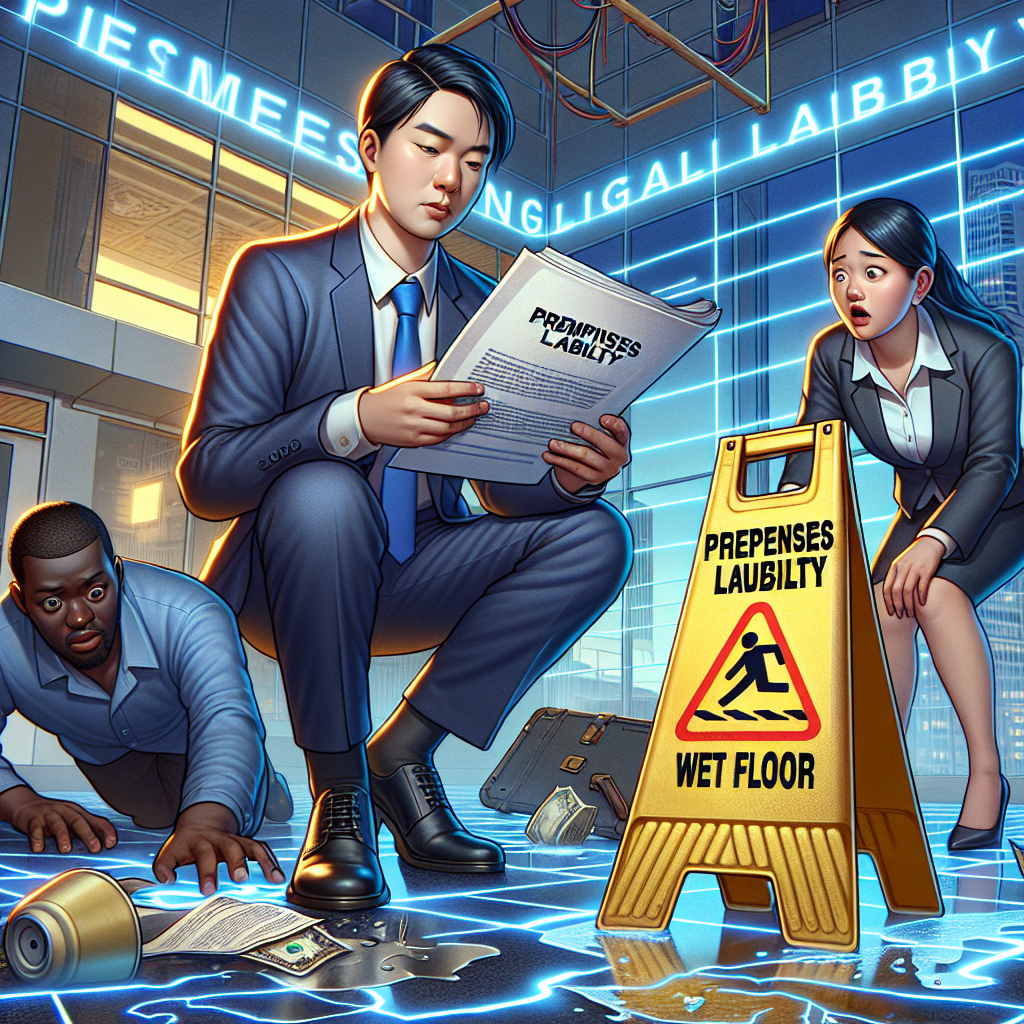Understanding Premises Liability in Personal Injury Law
As you traverse the complex labyrinth of personal injury law, one prominent aspect often permeates: Premises Liability. This legal concept, while somewhat ambivalent to many, is a cornerstone of many Personal Injury Lawyer’s practices, acting as the fulcrum around which multifaceted cases revolve.
This article delves into the nuances of:
- Demystifying the concept of Premises Liability
- The critical elements needed to establish a Premises Liability case
- Concrete examples of Premises Liability incidents
- The critical role of a Personal Injury Lawyer in a Premises Liability case
- Primary factors that can indeed impact your Premises Liability case, for better or worse
Prepare yourself, as we embark on a journey through the maze of premises liability, unlocking its secrets and unveiling the reality of its implications in the realm of Personal Injury Law. Whether you’re a property owner trying to understand the weight and breadth of your legal responsibilities, or an accident victim seeking rightful compensation, these invaluable insights cater to your quest for clarity and justice.
Demystifying the Concept of Premises Liability
The term ‘Premises Liability’ might seem intimidating at first glance, but it’s a crucial aspect of Personal Injury Law that people should know about. Simply put, Premises Liability refers to a property owner’s legal responsibility for accidents or injuries that occur on their property owing to the inadequate maintenance or unsafe conditions.
Critical Elements Needed to Establish a Premises Liability Case
In order to establish a successful Premises Liability case, a few critical elements must be proven. The first among these is that the defendant (in this case, the property owner or occupant) held duty of care towards the plaintiff (the one who got injured). This implies that the defendant was responsible for maintaining a safe environment on their property.
Another important facet is proving negligence. This means demonstrating that the defendant knew, or should have known about the unsafe condition, and failed to rectify it, leading to the accident. For instance, if a visitor suffers a ‘slip and fall’ because of an icy sidewalk that the property owner didn’t clear, it could potentially be grounds for a Premises Liability claim.
Finally, it must be shown that the injury occurred directly as a result of the defendant’s negligence. It is also the plaintiff’s responsibility to show that they were not reckless and did not willingly put themselves in a risky situation.
The Role of a Personal Injury Lawyer in a Premises Liability Case
Personal Injury Lawyers, like us at tomkileylaw.com, play a pivotal role in these cases. Beginning from offering a legal consultation, to proving the defendant’s negligence, establishing the liability, and ensuring your right to accident compensation; our attorneys can provide comprehensive legal help at every step of the process.
In the daunting landscape of personal injury law, assistance from an experienced attorney can significantly increase your chances of claim settlement. We understand the finer aspects of premises liability which allows us to approach your case with the precision it deserves. Remember, securing the right legal representation is not just about filing a compensation claim, it’s about enforcing your legal rights and ensuring justice is served.
Critical Elements Needed to Establish a Premises Liability Case
A key component of personal injury law is understanding the elements required to establish a successful Premises Liability case. In essence, premises liability deals with accidents or injuries that occur on another person or entity’s property due to the property owner’s negligence. In order to win a premises liability case, the plaintiff—or the person who was injured—must prove several critical elements.
The Element of Duty of Care in a Premises Liability Case
One of the critical components to verify is the duty of care. This legal principle requires that the property owner must maintain their premises in a reasonably safe condition, to ensure the safety of others who lawfully enter the property. If a hazardous condition exists, the owner has a responsibility either to eliminate the danger (if possible) or to warn others of its presence. A failure in the duty of care can be grounds for a premises liability case. However, establishing this legal responsibility is often a complex process that requires an adept personal injury lawyer’s knowledge and expertise.
The Condition of the Property and the Plaintiff’s Status
Another crucial element in a premises liability case is proving that the owner knew, or should have known, about the hazardous condition that led to the injury. For instance, if a guest on the property had a slip and fall accident due to a known leak or spill that wasn’t cleaned up, this might help establish the property owner’s negligence.
However, a significant aspect of premises liability law to keep in mind is the status of the plaintiff at the time of the accident. There are different levels of duty owed to individuals on a property, such as invitees, licensees, or trespassers. Typically, the highest level of care is owed to invitees—guests specifically invited onto the property. The type of visit can impact the success of a premises injury claim and your potential for accident compensation.
While laying the groundwork for successful liability claims may seem overwhelming, legal consultation can make the process much more manageable. At tomkileylaw.com, our personal injury lawyers specialize in premises liability cases, including complex negotiations with defendants and striving for optimal claim settlements. With our help, you can better understand your legal rights and navigate the complexities of injury law without undue stress.
Examples of Premises Liability Incidents
Premises Liability is a term that might sound a little technical, but its implications run across daily life. As experts in Injury Law at tomkileylaw.com, we understand how these incidents unfold and affect real people. To shed light on the concept, let’s discuss some examples of Premises Liability incidents you may encounter.
Slip and Fall Incidents
One of the most common examples of premises liability is the “Slip and Fall” incident. This can occur due to faulty or poorly maintained floor surfaces that lead to a person slipping or tripping and sustaining injuries. The property owner could be held legally responsible if it’s proven that the owner neglected their duty of care or violated their legal responsibility to maintain a safe environment.
Accidents Due to Inadequate Property Security
Not all Premises Liability cases are about physical conditions on the property. Many times, they could be about inadequate security leading to an accident or assault. If a property owner fails to provide necessary security measures, resulting in harm to visitors or tenants on their property, they can potentially be at the receiving end of a hefty compensation claim.
Hazardous Conditions
In certain situations, a property owner’s failure to address hazardous conditions can lead to a major Premises Liability case. Whether it’s a concealed hole in the backyard, unsafe construction areas, or even unrestrained dogs, these and other similar conditions can give rise to serious injuries, leading to a Personal Injury Claim against the owner.
Understanding these examples can help elucidate what Premises Liability entails and how to identify when you may need legal help. The team at tomkileylaw.com is readily available for a legal consultation to help you navigate your way through a Premises Liability Case should you find yourself dealing with such a situation.
The Role of a Personal Injury Lawyer in a Premises Liability Case
With regards to Premises Liability cases, a qualified Personal Injury Lawyer plays a critical role in establishing the facts, substantiating your claim, and ensuring fair compensation. The overarching duty of the Personal Injury Lawyer from tomkileylaw.com involves providing unwavering legal help to the plaintiff, scrutinizing the details of the accident, exploring the defendant’s duty of care, and thus determining the level of legal responsibility for the premises injury.
Understanding Duty of Care and Legal Responsibility
Primarily, the attorney’s responsibility is to ascertain that the property owner failed in their duty of care. This can involve proving laxity in maintaining a safe environment that could have averted a Slip and Fall accident, for instance. A detailed exploration into the circumstances surrounding the accident plays a significant role in defining the owner’s property liability.
The Personal Injury Lawyer would use indisputable evidence to demonstrate that the defendant knew or should have known about the dangerous condition, and instead of taking necessary precautions, overlooked it, culminating in the injury. This not only sets the course for legal responsibility but also paves the way to claim compensation.
Legal Consultation and Claim Settlement
Often, a Liability Case may seem straightforward, but legal loopholes and complex state laws can alter the dynamics. That’s where the expertise of a Personal Injury Lawyer from tomkileylaw.com becomes vital. They can navigate you through the strenuous process, make sure your legal rights are not violated, and ensure a fair resolution to the case. This can involve negotiations with the defendant’s attorney towards a claim settlement or taking the battle to courtrooms, if required.
In sum, the Personal Injury Lawyer’s role extends beyond just legal representation. It encompasses a comprehensive study of the injury incident, the violation of a safe environment, determining negligence on part of the defendant, all aimed towards ensuring a fair Accident Compensation to the plaintiff.
Factors that Can Impact Your Premises Liability Case
Premises liability cases, like other areas of injury law, are complex and multifaceted. Not all accidents resulting in injuries lead to valid premises liability claims. A host of factors can influence the outcome of your premises liability case, affecting your chance for receiving proper accident compensation.
The Proof of Ownership and Control
One crucial element in every premises liability case is determining who had control over the property at the time of the accident. Did the injury take place on a property owned, rented, or otherwise controlled by the defendant? If yes, then the property owner liability can be established. However, this can become complicated if multiple parties had some level of control over the space, for instance, in multi-tenant commercial buildings or rental properties.
The Establishment of Negligence
Another critical factor influencing premises liability claim results lies in demonstrating negligence. This involves proving that the defendant failed to exercise reasonable care in maintaining a safe environment on their premises, leading to the accident. Establishing the defendant’s duty of care, proving their violation of this duty, and linking this negligence to the plaintiff’s injuries are key steps your personal injury lawyer at tomkileylaw.com will guide you through. This is integral to a successful compensation claim, be it an incident of slip and fall, harmful exposure to hazardous materials, or any other form of premises injury.
Whether you are seeking legal consultation, strive for a fair claim settlement, or want to know more about your legal rights in a premises liability case, an experienced personal injury lawyer can make all the difference. With strategic legal assistance, understanding the dynamics of premises liability and traversing the complicated terrain of injury law can become significantly less daunting. Knowledge of these factors impacting your case, paired with the support of a seasoned legal team, can place you at a more advantageous position in your pursuit of justice and compensation.
Elevating Your Legal Ground in the Face of Premises Liability
Navigating the intricate corridors of Premises Liability can be daunting, but understanding this heightened aspect of Injury Law is vital to securing appropriate compensation after an injury. As we have learned, the critical elements needed to establish a Premises Liability case involve the defendant’s responsibility, the plaintiff’s injury, and the relation between these two factors. While incidents like slip-and-fall accidents vividly illustrate Premises Liability, it is important to realize that this legal concept is, in fact, an umbrella term covering a myriad of potential situations.
Engaging a skillful Personal Injury Lawyer from a reputable firm such as tomkileylaw.com could be instrumental in effectively articulating your claim and advocating for your rights. Various factors like the plaintiff’s behavior at the time of the accident, the property owner’s knowledge of the hazard, and the presence or absence of a ‘Duty of Care’ can dramatically impact the outcome of your Liability Case. Having the right legal help could spell the difference not only between winning and losing a case, but also between full and partial compensation. Armed with this knowledge, you can now step into the legal battleground with increased confidence, ready to fight for the justice and compensation you deserve.




